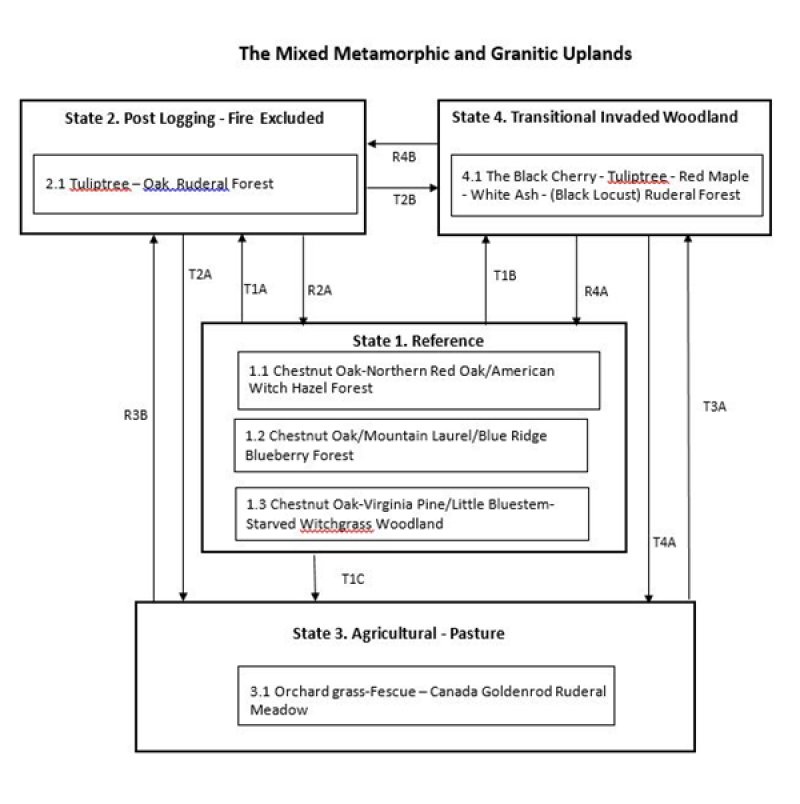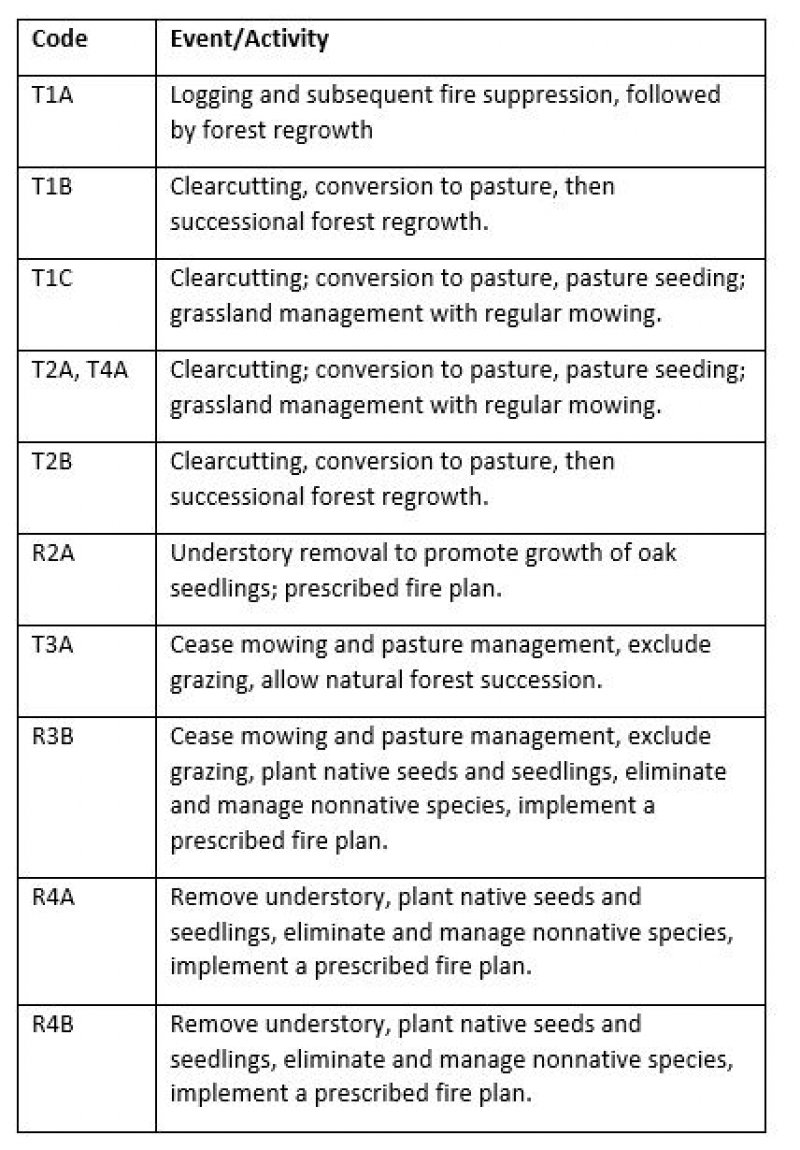
Natural Resources
Conservation Service
Ecological site F130AY001PA
Mixed Metamorphic And Granitic Upland
Last updated: 9/27/2024
Accessed: 12/22/2025
General information
Provisional. A provisional ecological site description has undergone quality control and quality assurance review. It contains a working state and transition model and enough information to identify the ecological site.
MLRA notes
Major Land Resource Area (MLRA): 130A–Northern Blue Ridge
Major Land Resource Area 130A is in the Northern Section of the Blue Ridge Province of the Appalachian Highlands. The region is characterized by rugged mountains with steep slopes, sharp crests, and narrow valleys. The mountain range forms a narrow band that runs north to south between the Piedmont Upland Section to the east, the Ridge and Valley section to the west, and the Southern Section of the Blue Ridge to the south. Stream dissection is deep and intricate. Major streams and their tributaries flow through gorges and gaps. Elevation ranges from about 820 feet (250 meters) in the lower valleys and on footslopes along the Potomac River just east of Harpers Ferry, where West Virginia joins Maryland and Virginia, to more than 4,200 feet (1,280 meters) along the Appalachian Trail in Bedford County, Virginia. Apple Orchard Mountain, the highest peak, is at an elevation of 4,225 feet (1,288 meters) (USDA 2006).
The backbone of the northern Blue Ridge is an anticline composed of rocks that can be can be divided into geological groupings based on age. In general, the oldest rocks are the furthest east, and become younger towards the west (Fichter and Baedke, 2000; Barnes and Sevon, 2002). The first group are plutonic rocks that formed when liquid molten rock, called magma, solidified deep within the earth’s crust over a billion years ago. Collectively referred to as the Grenville rocks, they make up much of the eastern half of the mountains and are composed of granites, gneisses, and granulites. The second group, characterized by the Catoctin greenstone formation, is slightly younger, and is made up of metabasalts and metarhyolites, types of igneous rocks that have been metamorphosed by heat and pressure. The third group was formed during the Cambrian period about 500 million years ago and are represented by the Harpers, Antiedam, Weverton, and Loudoun formations which comprise the Chilhowee group. These rocks are primariliy quartzites, phyllites, and meta-sandstones, and form the western flank of the Blue Ridge.
Preliminary ecological site differentiation is based on these three main age groups and geologies. The variable characteristics of the underlying rocks give rise to different soil physical and chemical properties and exert control on the landscape, slope shape, aspect, and elevation, all of which affect vegetation.
Classification relationships
This ecological site is found in Major Land Resource Area 130a - the Northern Blue Ridge. MLRA 130a is located within Land Resource Region N - the East and Central Farming and Forest Region (USDA 2006), and in United States Forest Service ecoregion M221D - the Central Appalachian Broadleaf Forest-Coniferous Forest-Meadow Province (Bailey 1995). In addition, MLRA 130a falls within area #66 of EPA Ecoregion Level III - the Blue Ridge Mountains (USEPA 2013). The Mixed Metamorphic And Granitic Upland ecological site occurs primarily within 66a - Northern Igneous Ridges of EPA Ecoregion IV (Woods et. al. 1996).
Northeastern Interior Dry-Mesic Oak Forest System - CES202.592 and
• Quercus prinus - Quercus rubra / Hamamelis virginiana Forest Association - CEGL006057
Central Appalachian Dry Oak-Pine Forest System - CES202.591
• Quercus prinus - (Quercus coccinea, Quercus rubra) / Kalmia latifolia / Vaccinium pallidum Forest Association - CEGL006299
Central Appalachian Pine-Oak Rocky Woodland System - CES202.600
• Quercus prinus - Pinus virginiana - (Pinus pungens) / Schizachyrium scoparium - Dichanthelium depauperatum Woodland Association - CEGL008540
(NatureServe 2017).
Ecological site concept
The Mixed Metamorphic and Granitic Upland ecological sites are located in the Northern Blue Ridge region of the Appalachian highlands. This ecological site is found on mountain slopes and mountain tops formed from granite, gneiss, granodiorite and granulite geology. Soils are generally acidic and deep, but can be shallow in the most convex areas. This site is distinguished from other mountainous and hilly areas of the Blue Ridge by its distinctive granitic geology. Other major ecological sites are underlain by metabasalts which weather into soils with more inherent fertility; quartzites and sandstones that tend to support vegetation that can withstand drier conditions; and, phyllite and schist geology that is similar in acidity but is generally drier, but not as dry as the quartzitic and sandstone areas.
Oak and hickory species characteristic of dry to mesic conditions are the dominant trees in mature stands. American Chestnut was once a major part of the canopy, but has been nearly eradicated by the chestnut blight. Disturbance agents in these forests include fire, wind throw, and ice damage. Gypsy moths can wreak havoc in the oak over story periodically. Fire suppression since the early 20th century in the eastern United States is believed to be leading to the overall replacement of oaks with fire-sensitive, non-oak species like maple, beech, birch, tuliptree, and black cherry.
Much of this ecological site has been subjected to human activity including logging, settlement, or other disturbance, therefore many of the forests are mid successional, in which pines (typically Virginia or white) or tuliptree may be codominant or dominant. These ruderal (growing where the natural vegetation has been disturbed by humans) forests and woodlands comprise about 9% of the area and are generally characterized by unnatural combinations of species, primarily natives, though they often contain slight or substantial numbers and amounts of species alien to the region as well. Less than 5 percent of this ecological site has been converted to agricultural use, mainly pasture and hayland.
Associated sites
| F130AY005PA |
Mixed Metamorphic - Metabasalt Footslopes And Terraces The Mixed Metamorphic-Metabasalt footslope and terraces ecological site occurs on lower slopes adjacent to and below the Mixed Metamorphic and Granitic Uplands ecological site and within concave areas and drainageways. It supports a more mesophytic (moisture loving) plant community. |
|---|
Similar sites
| F130AY003PA |
Phyllite-Metasandstone Upland The Phyllite-Metasandstone Upland provisional ecological site is very similar but soils are generally drier and more acidic. It supports a more xeric plant community. |
|---|
Table 1. Dominant plant species
| Tree |
(1) Quercus prinus |
|---|---|
| Shrub |
(1) Hamamelis virginiana |
| Herbaceous |
Not specified |
Click on box and path labels to scroll to the respective text.

